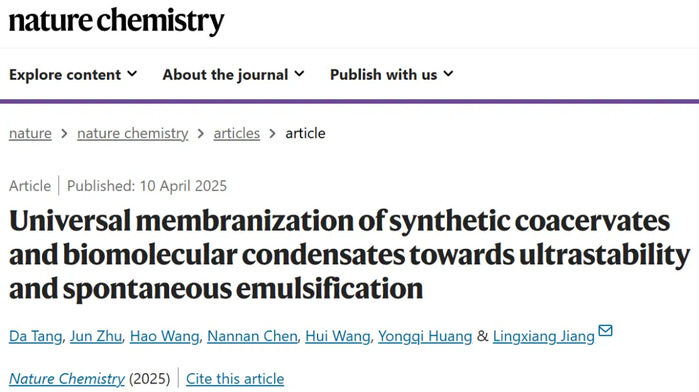A breakthrough study led by Professor Lingxiang Jiang's team at the School of Frontier Soft Matter, South China University of Technology (SCUT), has resulted in the development of innovative block polymers called 'Condensate-Amphiphilic Polymers' (CAPs). These remarkable polymers demonstrate universal stabilization capabilities at various condensed-phase-water interfaces, enabling unprecedented stabilization and spontaneous emulsification of both synthetic and biological condensed droplets. Published in Nature Chemistry, the research features PhD candidate Da Tang (Class of 2023, Soft Matter Science and Engineering) as first author, with Professor Jiang serving as corresponding author.

The Challenge of Stabilizing 'Brittle' Condensed Droplets
In everyday terms, oil represents a 'condensed phase' substance while water constitutes an 'aqueous phase' substance. Without protective membranes, condensed phase substances naturally tend to aggregate and coalesce, while remaining highly sensitive to environmental factors like temperature, pH, and salinity - often dissolving or precipitating unpredictably. This inherent instability severely limits their industrial applications and biological functions. Conventional surfactants and stabilizers typically fail to provide long-term stabilization for such droplets, as they usually target only specific droplet types based on viscosity, polarity, or charge characteristics.
Engineering a Universal Solution
Through systematic analysis of diverse condensed droplets, the SCUT team recognized the need for a fundamentally new approach. They designed a novel block polymer architecture featuring three distinct segments: a condensed-phase-compatible segment, a self-associating segment, and a hydrophilic segment. This ingenious design yielded an entire family of CAPs capable of stabilizing various small molecules, synthetic polymers, and even biomacromolecules like proteins and nucleic acids.
The CAP molecules' elongated structure enables them to span the aqueous-condensed phase interface effectively. The condensed-phase-compatible segment anchors firmly within the droplet, while the hydrophilic segment extends into the aqueous phase. The intermediate self-associating segment promotes stable membrane formation. This sophisticated architecture allows CAPs to target both synthetic condensates and biomolecular condensates with remarkable precision.
Observing the 'Sprouting' Phenomenon
Using confocal microscopy, the team discovered a fascinating 'sprouting' phenomenon at the microscopic level. Rather than forming smooth interfaces, the stabilized condensed phase develops wavy boundaries with the aqueous phase. Microscopic protrusions (1-2 μm in diameter) emerge and detach into the aqueous phase without coalescing, with the process repeating continuously at new interface locations.
This spontaneous emulsification process holds significant promise for reducing industrial energy consumption. In biological research, it may enable better simulation of membrane-free organelles and advance synthetic biology applications like microreactors and artificial cells.
Comprehensive Characterization and Future Directions
The study not only details CAP design and synthesis but also thoroughly investigates the molecular arrangement and mechanical properties of CAP monolayers at droplet interfaces. The team employed advanced techniques including optical micromanipulation and microfluidics to assess fusion resistance, membrane bending modulus, droplet diffusion, and interfacial permeability changes.
Looking ahead, the researchers aim to enhance CAP functionality to create precisely regulated, selectively permeable 'membrane-encapsulated condensates.' Such advancements could revolutionize drug delivery systems, novel materials development, and the simulation of cellular processes, providing powerful new tools for artificial cell research, organelle modeling, and bioengineering applications.
As team members note, processes once observable only in living systems may now be recreated in chemical laboratories through CAP technology, opening exciting new frontiers in soft matter science and bioengineering.





